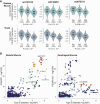Analysis of Glucocorticoid-Related Genes Reveal CCHCR1 as a New Candidate Gene for Type 2 Diabetes
- PMID: 33150273
- PMCID: PMC7594651
- DOI: 10.1210/jendso/bvaa121
Analysis of Glucocorticoid-Related Genes Reveal CCHCR1 as a New Candidate Gene for Type 2 Diabetes
Abstract
Glucocorticoids have multiple therapeutic benefits and are used both for immunosuppression and treatment purposes. Notwithstanding their benefits, glucocorticoid use often leads to hyperglycemia. Owing to the pathophysiologic overlap in glucocorticoid-induced hyperglycemia (GIH) and type 2 diabetes (T2D), we hypothesized that genetic variation in glucocorticoid pathways contributes to T2D risk. To determine the genetic contribution of glucocorticoid action on T2D risk, we conducted multiple genetic studies. First, we performed gene-set enrichment analyses on 3 collated glucocorticoid-related gene sets using publicly available genome-wide association and whole-exome data and demonstrated that genetic variants in glucocorticoid-related genes are associated with T2D and related glycemic traits. To identify which genes are driving this association, we performed gene burden tests using whole-exome sequence data. We identified 20 genes within the glucocorticoid-related gene sets that are nominally enriched for T2D-associated protein-coding variants. The most significant association was found in coding variants in coiled-coil α-helical rod protein 1 (CCHCR1) in the HLA region (P = .001). Further analyses revealed that noncoding variants near CCHCR1 are also associated with T2D at genome-wide significance (P = 7.70 × 10-14), independent of type 1 diabetes HLA risk. Finally, gene expression and colocalization analyses demonstrate that variants associated with increased T2D risk are also associated with decreased expression of CCHCR1 in multiple tissues, implicating this gene as a potential effector transcript at this locus. Our discovery of a genetic link between glucocorticoids and T2D findings support the hypothesis that T2D and GIH may have shared underlying mechanisms.
Keywords: corticosteroid; diabetes; genetics.
© The Author(s) 2020. Published by Oxford University Press on behalf of the Endocrine Society.
Figures




References
-
- Liu XX, Zhu XM, Miao Q, Ye HY, Zhang ZY, Li YM. Hyperglycemia induced by glucocorticoids in nondiabetic patients: a meta-analysis. Ann Nutr Metab. 2014;65(4):324-332. - PubMed
-
- Perez A, Jansen-Chaparro S, Saigi I, Bernal-Lopez MR, Minambres I, Gomez-Huelgas R. Glucocorticoid-induced hyperglycemia. J Diabetes. 2014;6(1):9-20. - PubMed
-
- McDonough AK, Curtis JR, Saag KG. The epidemiology of glucocorticoid-associated adverse events. Curr Opin Rheumatol. 2008;20(2):131-137. - PubMed
-
- Donihi AC, Raval D, Saul M, Korytkowski MT, DeVita MA. Prevalence and predictors of corticosteroid-related hyperglycemia in hospitalized patients. Endocr Pract. 2006;12(4):358-362. - PubMed
Grants and funding
LinkOut - more resources
Full Text Sources
Research Materials
